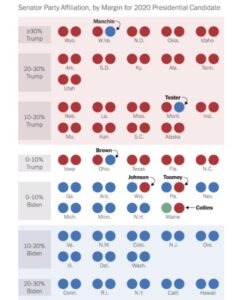Obama said he wanted to do this too, in the sense of supplanting the Reagan economic paradigm by a new paradigm that would do to Reaganomics what Reaganomics did to the New Deal. He didn’t get there. Could Biden? Richard North Patterson thinks so and explains how/why in an excellent article on The Bulwark. I agree it’s a live possibility and one that progressives should exert all their efforts to supporting. If we get there, so many, many other things become possible.
“On Tuesday, Fed Chairman Jerome Powell warned lawmakers that “the economic recovery remains uneven and far from complete, and the path ahead is highly uncertain”—while minimizing the risks of inflation. Moreover, our unemployment statistics ignore people who have stopped looking for work, as many Americans rendered jobless by the pandemic have; if they are included in the total, the unemployment rate rises to a dispiriting 10 percent or higher.
Given all this, Biden refuses to cut his plan. To circumvent GOP opposition, he is using the budget reconciliation process which requires a mere majority in the Senate—meaning every Democrat plus Vice President Kamala Harris…..
Most likely, Biden will sign his proposal into law by mid-March—a major legislative victory which sets the template for his presidency.
But this is a mere down payment on his ultimate ambition: supplanting Reagan’s paradigm with his own.
His team envisions spending up to $3 trillion on a program which, as spokeswoman Jen Psaki described it, “will make historic investments in infrastructure—in the auto industry, in transit, in the power sector—creating millions of good union jobs [while] addressing the climate crisis head on.” His goal evokes the New Deal: creating a more resilient and inclusive economy through federal intervention financed by higher taxes on the wealthy.
Such a sweeping agenda will alienate Republicans and unnerve moderate Democrats. But, among other things, it is aimed at a problem which upended bipartisan support for free trade, and provoked Trump’s ill-considered tariff wars: the loss of American jobs through globalization—including to China.
In a penetrating article for the New York Times, Noam Scheiber describes its genesis: Biden’s desire to create stable jobs which would not require blue-collar workers to relocate their families or undertake extensive retraining. One focus is government investment in electric vehicles whose components could be manufactured in America—providing employment, addressing the climate crisis, and strengthening green energy innovation.
Such “industrial policy”—government intervention to fortify selected industries—has long been debated by economists and derided by conservatives. One effort during the Obama years, the failed solar panel company Solyndra, became a notorious example of federal fecklessness.
But, Scheiber notes, recent studies of governmental support for Chinese industries suggests enduring successes. If our archrival can strengthen its domestic manufacturers at our expense, the argument goes, why can’t we?
Between 2001 and 2007, Scheiber writes, America lost 3 million manufacturing jobs—most likely the result of our free trade policies toward China. Some prominent Republicans—Tom Cotton, Marco Rubio, and Mitt Romney—have become particularly vocal about China’s predatory practices and economic sway. Even Treasury Secretary Janet Yellen, for years a dedicated free trader, acknowledges the need to protect American workers from the downside of globalism.
This may create some space for bipartisan agreement. The potential for job creation underwritten by government is considerable: making electric parts; building or upgrading manufacturing facilities; creating and installing chargers. Economic nationalism is no longer brain-dead protectionism, but a potential strategy for spreading prosperity.
Certainly, it’s past time to rebuild our infrastructure, strengthen our broadband capacity, and protect our energy grid from calamity. To do otherwise means abandoning a first world economy.
No doubt Biden won’t get all he wants; likely he will have to advance his goals through piecemeal legislation, or through the budget reconciliation process, which carries other risks. But in challenging times, average Americans are far more concerned with their families and their futures than the nostrums of limited government.”




